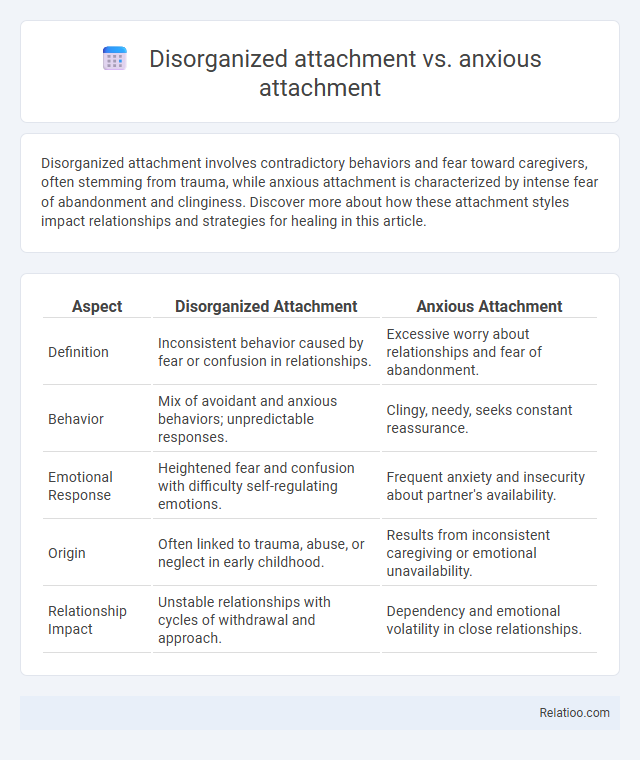Disorganized attachment involves contradictory behaviors and fear toward caregivers, often stemming from trauma, while anxious attachment is characterized by intense fear of abandonment and clinginess. Discover more about how these attachment styles impact relationships and strategies for healing in this article.
Table of Comparison
| Aspect | Disorganized Attachment | Anxious Attachment |
|---|---|---|
| Definition | Inconsistent behavior caused by fear or confusion in relationships. | Excessive worry about relationships and fear of abandonment. |
| Behavior | Mix of avoidant and anxious behaviors; unpredictable responses. | Clingy, needy, seeks constant reassurance. |
| Emotional Response | Heightened fear and confusion with difficulty self-regulating emotions. | Frequent anxiety and insecurity about partner's availability. |
| Origin | Often linked to trauma, abuse, or neglect in early childhood. | Results from inconsistent caregiving or emotional unavailability. |
| Relationship Impact | Unstable relationships with cycles of withdrawal and approach. | Dependency and emotional volatility in close relationships. |
Understanding Attachment Theory
Understanding attachment theory reveals key differences between disorganized attachment, anxious attachment, and other attachment styles; disorganized attachment is characterized by a lack of clear attachment behavior, often resulting from trauma or neglect, while anxious attachment involves intense fear of abandonment and a strong desire for closeness. Your relational patterns and emotional responses are deeply influenced by these attachment styles, shaping how you connect with others and manage stress. Recognizing these differences enables more effective strategies for healing and building secure, healthy relationships.
Defining Disorganized Attachment
Disorganized attachment is characterized by inconsistent, contradictory behaviors toward caregivers, combining both avoidance and anxiety patterns often linked to trauma or neglect. Unlike anxious attachment, which centers on fear of abandonment and excessive need for reassurance, disorganized attachment reflects a fundamental confusion in emotional regulation and caregiving expectations. Understanding your attachment style, especially disorganized attachment, is crucial for addressing relational challenges and fostering healthier emotional connections.
Characteristics of Anxious Attachment
Anxious attachment is characterized by intense fear of abandonment, excessive need for reassurance, and heightened emotional sensitivity in relationships. Compared to disorganized attachment, which combines fear and confusion leading to unpredictable behavior, anxious attachment primarily manifests as clinginess and worry over partner's availability. Understanding your anxious attachment style can help improve emotional regulation and foster healthier interpersonal connections.
Key Differences Between Disorganized and Anxious Attachment
Disorganized attachment is characterized by contradictory behaviors and a lack of a clear strategy for seeking comfort, often stemming from trauma or inconsistent caregiving, while anxious attachment involves a consistent worry about rejection and intense desire for closeness. You may notice that individuals with disorganized attachment display unpredictable responses and fear both closeness and abandonment, contrasting with anxious attachment's persistent need for reassurance. Understanding these key differences helps tailor support strategies for healthier emotional connections.
Causes and Risk Factors
Disorganized attachment often arises from inconsistent or frightening caregiving, frequently linked to trauma, abuse, or neglect during early childhood, creating confusion and fear in your emotional bonds. Anxious attachment typically develops when caregivers are unpredictably responsive or emotionally unavailable, leading to heightened anxiety and fear of abandonment in relationships. Both attachment styles are influenced by risk factors such as parental mental illness, unresolved trauma, and unstable family environments, which disrupt the child's ability to form secure connections.
Impact on Adult Relationships
Disorganized attachment in adults often leads to contradictory behaviors, fear of abandonment, and difficulty regulating emotions, resulting in unstable and unpredictable relationships. Anxious attachment manifests as an intense need for closeness, fear of rejection, and heightened sensitivity to partner cues, causing clinginess and dependency issues. Disorganized attachment combines elements of both anxious and avoidant patterns, frequently leading to significant relational turmoil and challenges in trust and intimacy.
Signs and Symptoms in Children
Children with disorganized attachment often display contradictory behaviors such as seeking comfort yet showing fear or confusion towards caregivers, accompanied by signs of freezing or dissociation under stress. Those with anxious attachment may exhibit clinginess, heightened distress when separated, and difficulty calming down, reflecting their insecurity about caregiver availability. Your observation of these distinct signs can help identify attachment patterns and guide appropriate supportive interventions.
Healing and Therapeutic Approaches
Healing from disorganized attachment involves creating a safe therapeutic environment where you can explore and integrate fragmented emotions and traumatic memories, often through trauma-informed therapies like EMDR or somatic experiencing. Anxious attachment benefits from interventions that build emotional regulation and secure relational patterns, such as cognitive-behavioral therapy (CBT) and attachment-based therapy, fostering trust and reducing fear of abandonment. Therapists often combine modalities tailored to individual needs to address the complex symptoms of both disorganized and anxious attachment, promoting resilience and healthy connection.
Long-Term Effects on Mental Health
Disorganized attachment is closely linked to heightened risks of developing dissociative disorders, severe anxiety, and unpredictable emotional regulation difficulties in adulthood. Anxious attachment often results in chronic feelings of insecurity, increased vulnerability to depression, and difficulties in maintaining stable relationships. Both attachment styles contribute to long-term mental health challenges, but disorganized attachment is particularly associated with complex trauma and greater psychological instability.
Supporting Individuals with Attachment Challenges
Supporting individuals with disorganized, anxious, or disorganized attachment requires tailored approaches that address their unique emotional and behavioral patterns. Your intervention strategies should prioritize creating a safe, consistent environment to build trust and regulate emotions effectively. Therapeutic techniques such as trauma-informed care and emotionally focused therapy can significantly improve attachment security and relational outcomes.

Infographic: Disorganized attachment vs Anxious attachment
 relatioo.com
relatioo.com